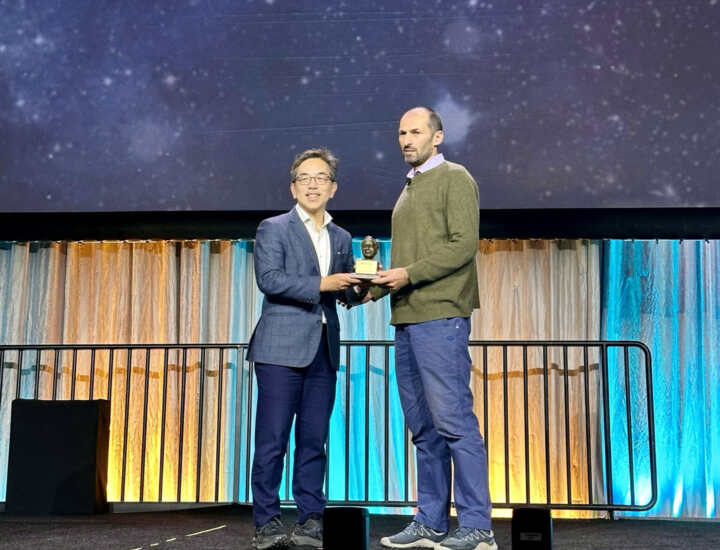4 June, 2025 | Author: By Professor Lauren Ayton and Professor Erica Fletcher, Retina Australia Scientific and Medical Advisory Committee Members , and Dr Ceecee Britten-Jones, Retina Australia Board Member
For those living with inherited retinal diseases (IRDs), and those who research them, staying informed can be challenging with the rapid progress in the field. International conferences are an important opportunity for the world-leading scientists and clinicians to meet and share their findings, build new collaborations, and speed up translation of science to practice.
At the start of May 2025, our Scientific and Medical Advisory Committee (SMAC) members, Professor Lauren Ayton, Professor Erica Fletcher and Professor Michael Kalloniatis, and Board Member, Dr Ceecee Britten-Jones, attended the annual Association for Research in Vision and Ophthalmology (ARVO) meeting. ARVO is the world’s largest and most respected eye and vision research organisation. Founded in 1928, ARVO hosts an annual meeting that attracts over 11,000 researchers from more than 75 countries, providing a forum for the latest breakthroughs in vision science. The meeting this year was held in Salt Lake City, Utah, USA.

XLRP Clinical Trial Result
The biggest news of the conference, which has already been shared with Retina Australia members, was that sadly the Janssen Pharmaceuticals RPGR gene therapy trial did not meet its primary endpoints, although there was some positive news.
Janssen, a division of Johnson & Johnson, recently completed clinical trials for their gene therapy targeting X-linked retinitis pigmentosa (XLRP) caused by mutations in the RPGR gene. The therapy, known as botaretigene sparoparvovec (formerly JNJ-81201887), aimed to deliver a functional copy of the RPGR gene to retinal cells. Despite initial promise, the Phase 3 LUMEOS trial failed to meet its primary endpoint – an assessment of vision-guided mobility. The study involved 95 patients treated over a 52 week period. However, there were signs of efficacy in other vision measures, and some of the patients did very well after the treatment. As such, Janssen will continue to analyse the data and determine their next steps.
Despite this disappointing news, many exciting advances were reported at the meetings. Lauren, Ceecee and Erica have provided the following update from the conference, including summaries on gene editing, RNA therapies, cell therapies, and drug treatments, all aimed at preserving or restoring vision in people with IRDs.
Gene Replacement Approaches
RPGR-Associated X-Linked Retinitis Pigmentosa
Separate to the Janssen trial mentioned previously, another treatment for RPGR-related X-linked retinitis pigmentosa (XLRP) is being evaluated in a clinical trial by Beacon therapeutics (VISTA clinical trial). The therapy, known as laruparetigene zovaparvovec, aims to deliver a functional copy of the RPGR gene to retinal cells. The main difference between the Janssen and Beacon treatments is the size of the protein that is produced by the therapy.
The VISTA trial is a Phase 2/3 study designed to assess the safety and potential efficacy of laruparetigene zovaparvovec. It’s currently enrolling patients across multiple sites, including Melbourne and Sydney. The trial is expected to complete enrolment in the coming months. At the conference, Dr Mark Pennesi from the Retina Foundation of the Southwest presented data on the previous Phase 2 DAWN study of this treatment, showing it is safe, and supporting the expansion into the VISTA study.
Gene Editing Approaches
CEP290-Associated Retinitis Pigmentosa
Dr Mark Pennesi also presented promising results for a gene editing treatment targeting CEP290-related retinal dystrophy, which includes conditions like Leber congenital amaurosis (LCA).
The treatment, called Edit-101, showed functional improvement in 11 out of 14 patients. It was well-tolerated, with only some cases of mild inflammation. Importantly, both patients with two copies of the mutation (homozygous) and those with one copy (heterozygous) responded to the treatment. This is significant because it expands the potential patient population who could benefit. The editing is confined to the photoreceptors (light-sensing cells in the retina) due to the design of the treatment.
While these results are encouraging, Dr Pennesi notes that it is only suitable for people who have specific genetic variants, and so is not widely available for all individuals with CEP-290 associated disease.
Stargardt Disease
Dr Bence György from the Institute of Molecular & Clinical Ophthalmology Basel (IOB) discussed a new approach for treating Stargardt disease using precision base editing. This technique corrects a single DNA base without breaking the DNA strand, which is different from the CRISPR gene-editing method. The treatment targets a specific mutation that affects about 15% of Stargardt disease patients.
In laboratory studies using human retinal tissue, they achieved about 70% successful editing. Initial tests in non-human primates had some toxicity issues, but changing the delivery method resolved these problems. Their goal is to preserve 15-20% of the cone cells in the central retina (fovea), which could help maintain vision above the legal blindness threshold. This work is still in preclinical development, with no human trials underway.
PRPH2-Associated Retinitis Pigmentosa
Dr Renee Ryals from the Casey Eye Institute at Oregon Health and Science University is working on optimising a technique called prime editing for mutations in the PRPH2 gene, which can cause various forms of retinal degeneration. This research is still in the preclinical testing phase.
RNA-Based Therapies
Leber Congenital Amaurosis (LCA10)
Sepul Bio are developing a drug called Sepofarsen for a specific form of Leber congenital amaurosis (LCA10), caused by a mutation in the CEP290 gene. It has been in development for over 7 years, and 67 patients have been treated so far. While earlier trials showed promising results, with some patients experiencing significant vision improvements, a larger Phase 3 trial didn’t show statistically significant benefits overall. However, individual responses varied greatly, with some patients reporting life-changing improvements.
A new trial called Hyperion is now underway in the USA, which will treat one eye with the drug and use the other eye as a control. This design may help better understand the drug’s effects.
Usher Syndrome Type 2A (USH2A)
Another RNA-based therapy called ultevursen is being developed by Sepul Bio for patients with mutations in exon 13 of the USH2A gene, which can cause Usher syndrome type 2 and non-syndromic retinitis pigmentosa. An ongoing USA & UK clinical trial, called LUNA, will enrol 81 patients (adults and children over eight years of age) and follow them for the next two years. The first person was treated in late 2024 in Texas, USA, and the trial is progressing well to date.
Cell Therapies
Several research groups are exploring the use of cell therapies to treat various retinal diseases. Presentations at the ARVO conference included the following.
iPSC-Derived Photoreceptor Precursor Cells
Dr Byron L. Lam from the Bascom Palmer Eye Institute at the University of Miami is leading a clinical trial called CLARICO, supported by Bluerock Therapeutics. This is the first clinical trial to evaluate photoreceptor precursor cells derived from induced pluripotent stem cells (iPSCs) for treating primary photoreceptor diseases. The trial is currently enrolling patients in the USA.

hESC-Derived RPE Cells for Geographic Atrophy
Astellas Pharmaceuticals has completed a trial using human embryonic stem cell (hESC)-derived retinal pigment epithelium (RPE) cells to treat geographic atrophy, a late stage of dry age-related macular degeneration. The treatment, called ASP7317, was found to be safe. There were some early signs that it might be effective, but more research is needed.
RPE Patch for Retinitis Pigmentosa
Dr Christelle Monville from I-Stem, University of Evry Paris-Saclay, presented results from a trial using an RPE patch derived from human embryonic stem cells to treat retinitis pigmentosa. The patch is encapsulated in gelatin, allowing the cells to survive for 48 hours during transplantation. Seven patients were treated, including five with MERTK mutations and two with LRAT mutations. The treatment showed good safety and tolerance. Some patients reported improvements, and there was evidence of preserved retinal anatomy and function.
EyeCyte-RPE for Geographic Atrophy
Another cell therapy approach using a cell suspension called EyeCyte-RPE is being developed for geographic atrophy. Nine patients have been implanted so far. Early results show vision improvements of 7 to 15 letters on eye charts. The treatment is awaiting approval to move to a Phase 2 clinical trial.
Small Molecule or Pharmaceutical Treatments
Several pharmaceutical companies are developing oral medications for various retinal conditions.
Tinlarebant for Stargardt Disease and Age-Related Macular Degeneration
Dr Hendrik Scholl from Germany presented updates on tinlarebant, an oral medication being developed by Belite Bio. The DRAGON study is testing the drug in young Stargardt disease patients (average age 15 years). DRAGON is a global study, which includes sites in Sydney and Melbourne. Another study called PHOENIX is testing the drug for age-related macular degeneration.
To date, the studies have shown that the oral tablet is safe and has evidence of slowing down progression of the diseases. Visual acuity was stabilised in the majority of subjects, with mean change from baseline of less than three letter scores under both standard and low luminance, throughout the two-year study. It is expected that DRAGON will be completed by the end of this year.
Gildeuretinol for Stargardt Disease
Michel Dahan from Alkeus Pharmaceuticals discussed their drug gildeuretinol – an oral, once-daily medication designed to replace natural vitamin A in the visual cycle without causing harmful byproducts. In clinical trials, it has shown promise in slowing the growth of retinal lesions in Stargardt disease patients. Some patients with early-stage disease have had stable vision for up to 7 years on the treatment. Unlike some other treatments, it doesn’t seem to cause problems with night vision or color perception.
NAC (N-Acetylcysteine) for Retinitis Pigmentosa
Dr Peter Campochiaro presented updates on using NAC, an antioxidant supplement, to treat retinitis pigmentosa. A Phase 2 study showed statistically significant improvements in visual acuity, though the changes were gradual and slow. A larger Phase 3 trial called NAC Attack is now underway, primarily in the USA. The dosage being used is 1800mg twice daily. Some patients experience mild gastrointestinal side effects, but these are manageable with conservative treatment.
NACA (N-Acetylcysteine Amide) for Usher Syndrome
The other current antioxidant trial underway for IRD has built from the work of Dr Campochiaro, and developed a different version of NAC, called NACA. Due to the different composition of the drug, previous work has shown that NACA has greater cell permeability than NAC, and so its proponents claim it could be up to three times more effective than oral NAC.
Halden Conner, from the company Nacuity, presented on the current trial for their drug NPI-001, which is being run in Australia. The results from this study are expected in the second half of 2025. Of interest, the drug is also being tested for the prevention of cataracts after eye surgery, and in a rare genetic kidney disease called nephropathic cystinosis.
Disulfiram for Retinal Degeneration
Dr Michael Telias discussed the potential use of disulfiram, a drug typically used to treat alcohol dependence, for retinal degeneration. The drug aims to reduce abnormal electrical signalling in the retina after photoreceptor loss. This could potentially improve the effectiveness of retinal prostheses and optogenetic therapies. It might also be a treatment option for Charles Bonnet syndrome, a condition where people with vision loss experience visual hallucinations. Two clinical trials are now active, but long-term safety of the drug for this use is not yet known.
Avacincaptad Pegol for Stargardt Disease
Astellas Pharmaceuticals has completed a trial of avacincaptad pegol, a complement inhibitor, in Stargardt disease patients. This drug has been approved in the USA for treatment of geographic atrophy secondary to age-related macular degeneration, and is under review with the Australian Therapeutic Goods Administration. Data analysis of the clinical trial in Stargardt Disease is just beginning, so results are not yet available.
Conclusion
While many of these treatments are still in various stages of research and development, they represent significant progress in the field of inherited retinal diseases.
We are pleased that the Australian research on inherited retinal diseases at the ARVO conference was also very well received, with presentations from many Retina Australia Committee/Board members, including A/Prof Fred Chen, Prof Erica Fletcher, Dr Ceecee Britten-Jones, and others.
Special mention to Retina Australia SMAC member, Prof Alex Hewitt (as pictured on the right), who leads several important IRD research programs, and was awarded ARVO’s prestigious Cogan Award at the conference. The Cogan Award, recognises a young researcher who has made substantial contributions to research in ophthalmology or visual science and shows great promise for future contributions. Congratulations Alex!

https://retinaaustralia.com.au/recent-research-updates-on-inherited-retinal-diseases-arvo-2025-summary/
Other Blogs

World Geographic Atrophy Day 2025
A New Era of Hope for Vision Preservation Geographic Atrophy (GA), a progressive and irreversible form of advanced age-related macular degeneration (AMD), has long been a...

World Research Summary by Dr Catherine Civil
Hot Off The Press There are some exciting happenings in the research world this month. Click on the hyperlinks for further...

Australia Approves Second Treatment for Geographic Atrophy
Astellas' IZERVAY® (avacincaptad pegol) has been approved for use in Australia by the TGA Astellas...
